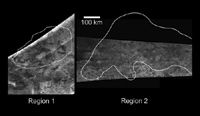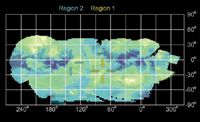Active Volcanoes in Space?
Spectrometer discovers signs of active cryovolcanoes on Saturn's largest moon, Titan.

Spectrometer discovers signs of active cryovolcanoes on Saturn's largest moon, Titan.
Molten lava, magma, and hot volcanic eruptions all come to mind when the phrase "active volcano" is mentioned, but this is not the case for Saturn's largest moon, Titan, where scientists have found evidence of ice volcanoes and ammonia frost.

Figure 1: These radar images show the outlines of regions "1" and "2," which have been hypothesized to be due to cryovolcanic activity. Image credit: NASA/JPL. Full image and caption.
As reported on www.nasa.gov, according to data collected during several fly-bys of Titan by NASA's Cassini spacecraft, scientists think the moon contains active cryovolcanoes, which spew super-chilled liquid into its atmosphere. Rather than erupting molten rock, it is theorized that the cryovolcanoes on Titan would erupt volatiles such as water, ammonia, and methane.
The international Cassini spacecraft is a cooperative project of NASA, the European Space Agency, and the Italian Space Agency. It has been orbiting Saturn and studying its rings and moons since 2004, with a projected end date of September 2010.
"Cryovolcanoes are some of the most intriguing features in the solar system," said Rosaly Lopes, a Cassini radar team investigation scientist from NASA's Jet Propulsion Laboratory in Pasadena, California. "To put them in perspective – if Mount Vesuvius had been a cryovolcano, its lava would have frozen the residents of Pompeii."
Changes in brightness and reflectance in two distinct regions were documented by visible and infrared mapping spectrometer data collected on Titan fly-bys from July 2004 to March 2006 has led scientists to believe the volcanoes are active. In one region, the reflectance of the surface surged upward and remained higher than expected. In the other region, the reflectance shot up but then trended downward. There was also evidence of ammonia frost at one of the two sites, which was only evident at times when the region was inferred to be active.
"Ammonia is widely believed to be present only beneath the surface of Titan," said Robert M. Nelson of JPL, a scientist for Cassini's Visual and Infrared Mapping Spectrometer team. "The fact that we found it appearing at times when the surface brightened strongly suggests that material was being transported from Titan's interior to its surface."

Figure 2: In this infrared map, the location of two regions that changed in brightness are labeled. These regions are hypothesized by some to be areas of cryovolcanic activity on Titan. Image credit: NASA/JPL/University of Arizona. Full image and caption.
Despite this evidence, there are some scientists, familiar with spectrometer data, who argue that the ammonia identification is not certain and the brightness changes might not be associated with changes on Titan's surface. Another possible explanation could be the transient appearance of ground "fogs" of ethane droplets very near Titan's surface, driven by atmospheric processes rather than geophysical. "There remains the possibility that the effect is caused by a local fog, but if so, we would expect to see it change in size over time due to wind activity, which is not what we see," said Nelson.
Another hypothesis offered by NASA scientists is that the Saturnian moon is taking its landform evolution cues from a moon of Jupiter.
"Like Callisto, Titan may have formed as a relatively cold body, and may have never undergone enough tidal heating for volcanism to occur," said Jeffrey Moore, a planetary geologist at the NASA Ames Research Center, Moffett Field, California. "The flow-like features we see on the surface may just be icy debris that has been lubricated by methane rain and transported down slope into sinuous piles like mudflows."
All of these hypotheses will be researched further, as scientists are still analyzing the data from Cassini's most recent fly-bys of Titan on December 5, 2008, and December 21, 2008.

Newsletter
Get essential updates on the latest spectroscopy technologies, regulatory standards, and best practices—subscribe today to Spectroscopy.
The Rising Role of Near-Infrared Spectroscopy in Biofuel Innovation
July 25th 2025A new bibliometric study published in Infrared Physics & Technology highlights the growing global impact of near-infrared (NIR) spectroscopy in biofuel research, revealing key trends, contributors, and future directions for advancing sustainable energy solutions.
Best of the Week: The Emerging Leader in Molecular Spectroscopy, Big Pharma’s Manufacturing Shift
July 25th 2025Top articles published this week include a feature article about big pharma’s investments in U.S.-based manufacturing, an article about the 2025 Emerging Leader in Molecular Spectroscopy Lingyan Shi, and some news items detailing the winners of the Coblentz Society’s student awards.